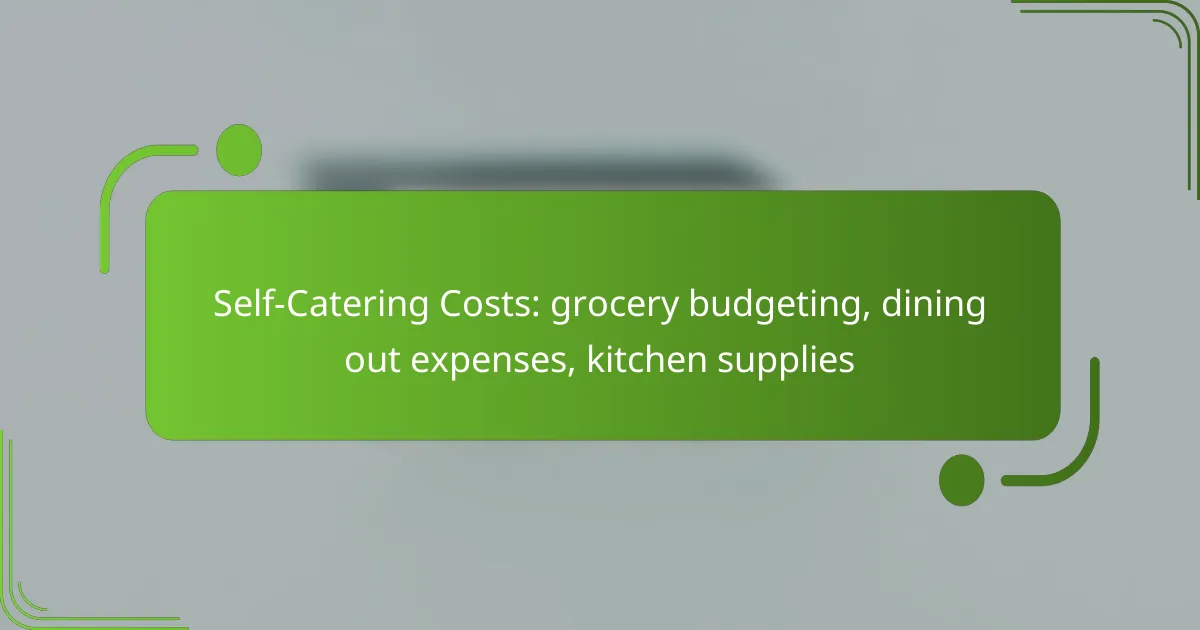Managing self-catering costs effectively requires careful grocery budgeting, consideration of dining out expenses, and investment in essential kitchen supplies. By planning your meals and shopping smartly, you can minimize food costs while enjoying the flexibility of cooking at home. Additionally, understanding the range of dining out expenses will help you allocate your budget wisely, ensuring a balanced approach to both home-cooked and restaurant meals.

What are the grocery budgeting strategies for self-catering in Australia?
Grocery budgeting for self-catering in Australia involves planning and smart shopping to manage expenses effectively. By employing various strategies, you can significantly reduce your food costs while ensuring you have the necessary supplies for your meals.
Using grocery price comparison apps
Grocery price comparison apps can help you find the best deals available at local supermarkets. These apps allow you to compare prices across different stores, ensuring that you pay the lowest possible amount for your groceries.
Popular apps in Australia include ShopSavvy and Frugl, which provide real-time pricing information. Regularly checking these apps can lead to savings of up to 20% on your grocery bills.
Creating a weekly meal plan
A weekly meal plan is essential for effective grocery budgeting. By planning your meals ahead of time, you can create a focused shopping list that minimizes impulse buys and reduces food waste.
Consider using a simple template to outline your meals for each day. This approach not only helps you stick to your budget but also ensures you have a variety of nutritious options throughout the week.
Shopping at local markets
Shopping at local markets can offer fresher produce at lower prices compared to supermarkets. Farmers’ markets often have seasonal fruits and vegetables that are more affordable and flavorful.
Additionally, purchasing directly from local vendors can foster community relationships and support local agriculture. Aim to visit these markets weekly to take advantage of the best deals.
Buying in bulk
Buying in bulk can lead to significant savings, especially for non-perishable items like grains, canned goods, and toiletries. Many stores offer discounts for bulk purchases, making it a cost-effective strategy.
Consider joining a bulk-buying group or shopping at warehouse clubs like Costco. Just ensure you have adequate storage space to prevent spoilage and waste.
Utilizing discount coupons
Utilizing discount coupons is a straightforward way to lower your grocery expenses. Many supermarkets in Australia offer loyalty programs and digital coupons that can be easily accessed through their websites or apps.
Make it a habit to check for available coupons before shopping. Combining these discounts with sales can lead to substantial savings, sometimes reducing your total bill by 30% or more.

How much should you budget for dining out in Australia?
In Australia, budgeting for dining out typically ranges from AUD 20 to AUD 60 per person per meal, depending on the type of restaurant and location. It’s essential to consider both casual dining and fine dining options when planning your budget.
Average cost per meal in major cities
The average cost of a meal in major Australian cities varies significantly. In Sydney and Melbourne, expect to pay around AUD 25 to AUD 50 for a standard meal at a mid-range restaurant. In contrast, smaller cities like Hobart or Adelaide may offer similar meals for AUD 20 to AUD 40.
Fast food options are generally cheaper, with prices ranging from AUD 10 to AUD 15 for a meal. However, dining at upscale establishments can easily exceed AUD 70 per person.
Dining out trends in Australia
Recent trends in Australia show a growing preference for casual dining experiences, with many consumers opting for cafes and bistros over formal restaurants. This shift has led to an increase in the popularity of shared plates and tapas-style dining, which encourages social interaction.
Additionally, there is a rising demand for plant-based and health-conscious menu options, reflecting a broader global trend towards healthier eating habits. Many restaurants are adapting their menus to cater to these preferences.
Popular restaurant price ranges
In Australia, restaurants typically fall into several price categories. Budget-friendly eateries, such as cafes and fast food outlets, usually charge between AUD 10 and AUD 20 per meal. Mid-range restaurants generally range from AUD 20 to AUD 50, while fine dining establishments can start at AUD 50 and go well above AUD 100 per person.
When dining out, consider looking for specials or early-bird menus, which can offer significant savings. Many restaurants also provide discounts on certain days of the week, making it easier to enjoy dining out without overspending.

What kitchen supplies are essential for self-catering?
Essential kitchen supplies for self-catering include basic cookware, necessary appliances, and effective storage solutions. These items help streamline meal preparation and ensure that groceries are stored properly, contributing to a successful self-catering experience.
Basic cookware and utensils
Basic cookware includes pots, pans, and baking sheets that are crucial for preparing a variety of meals. A non-stick frying pan, a medium-sized saucepan, and a large stockpot are often sufficient for most cooking needs.
Utensils such as knives, spatulas, and measuring cups are equally important. Investing in a good chef’s knife and a cutting board can significantly enhance your cooking efficiency.
Appliances for efficient cooking
Key appliances for self-catering include a reliable stove, oven, and microwave. These appliances allow for diverse cooking methods, from boiling and baking to reheating leftovers.
Consider adding a blender or food processor for meal prep, especially if you plan to make smoothies or sauces. A slow cooker can also be a great addition, allowing for easy meal preparation with minimal effort.
Storage solutions for groceries
Effective storage solutions are vital for keeping groceries fresh and organized. Invest in airtight containers for dry goods like pasta, rice, and cereals to prolong their shelf life.
Refrigeration is essential for perishable items; ensure your fridge is equipped with shelves and bins for optimal organization. Labeling containers can help you quickly identify contents and reduce food waste.

What factors influence self-catering costs in Australia?
Self-catering costs in Australia are influenced by various factors including location, seasonal food availability, and dietary preferences. Understanding these elements can help you budget effectively for groceries, dining out, and kitchen supplies.
Location and regional price variations
In Australia, self-catering costs can vary significantly based on location. Urban areas like Sydney and Melbourne typically have higher grocery prices compared to rural regions. For instance, fresh produce may cost more in city supermarkets, while local farmers’ markets in regional areas often offer better deals.
Additionally, transport costs can affect prices. Remote locations may see higher prices due to the cost of shipping goods. When budgeting, consider where you will be shopping and the availability of local produce to optimize your expenses.
Seasonal food availability
Seasonal food availability plays a crucial role in self-catering costs. Fresh fruits and vegetables are generally cheaper when they are in season, while out-of-season produce can be significantly more expensive. For example, buying strawberries in summer is more economical than in winter when they are imported.
To save money, plan your meals around seasonal ingredients. This not only reduces costs but also enhances the quality and flavor of your dishes. Keep an eye on local markets for seasonal specials to maximize your grocery budget.
Dietary preferences and restrictions
Your dietary preferences and restrictions can greatly impact self-catering costs. Special diets, such as gluten-free or vegan, may require specific ingredients that can be pricier than standard options. For instance, gluten-free products often come at a premium compared to their conventional counterparts.
When budgeting, consider how your dietary choices affect your grocery list. It may be beneficial to explore bulk buying or alternative sources for specialty items to reduce costs. Always check for sales or discounts on items that fit your dietary needs to help manage your budget effectively.

How can you reduce self-catering expenses?
Reducing self-catering expenses involves strategic planning and smart choices in grocery shopping, meal preparation, and ingredient usage. By implementing effective techniques, you can significantly lower your food costs while still enjoying delicious meals.
Meal prepping techniques
Meal prepping is a practical way to save money and time. By preparing meals in advance, you can buy ingredients in bulk, which often reduces costs. Aim to set aside a few hours each week to cook and portion out meals for the days ahead.
Consider using containers that are freezer-friendly to store meals. This allows you to take advantage of sales and seasonal produce without worrying about spoilage. A simple plan might include cooking a large batch of grains, proteins, and vegetables to mix and match throughout the week.
Choosing cost-effective ingredients
Selecting cost-effective ingredients is crucial for budget-friendly self-catering. Focus on buying seasonal fruits and vegetables, as they tend to be cheaper and fresher. Additionally, consider staples like rice, beans, and pasta, which provide filling options at low prices.
When shopping, compare unit prices to find the best deals. Generic brands often offer the same quality as name brands at a lower cost. Keep an eye out for sales and discounts, and plan your meals around these offers to maximize savings.
Utilizing leftovers creatively
Making the most of leftovers can significantly reduce food waste and costs. Instead of discarding uneaten food, think of ways to repurpose it into new dishes. For example, leftover roasted vegetables can be added to soups, salads, or omelets.
Another idea is to create a “leftover night” where you combine various remnants from the week into a single meal. This not only saves money but also encourages creativity in the kitchen. Keep a list of leftover ingredients and brainstorm meal ideas to ensure nothing goes to waste.
